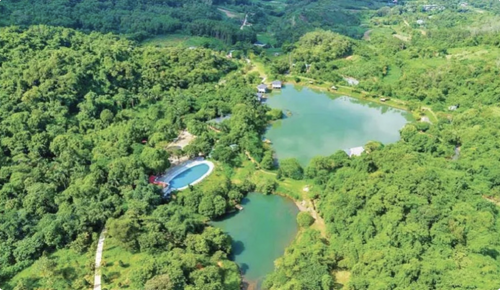This policy marks a major shift toward sustainable tourism practices, beginning with everyday items like toothbrushes, razors, plastic bags, and miniature toiletry bottles.
From 2026, all accommodation establishments and tourist destinations in the capital will be prohibited from using single-use plastic products. The city plans to expand this ban further, with a phase-out of free plastic bags in markets and convenience stores, and a full halt to the production and import of single-use and micro-plastic-containing items by 2031.
    |
 |
|
The Ba Vi mountainous area, dubbed the "green lung" of western Hanoi, is emerging as a model for sustainable tourism. |
Experts have hailed the move as a bold transformation for Hanoi’s tourism sector. According to Vu Quoc Tri, Secretary-General of the Vietnam Tourism Association, the green transition is not merely a trend, but a necessity. However, he acknowledged that the path is challenging, especially for small and micro businesses that make up the majority of Hanoi's tourism sector due to limited resources for eco-friendly upgrades. He called for tax incentives, green credit access, and stronger communication support to help businesses adapt.
The green transition is already being piloted at cafes, restaurants, and beverage outlets within the downtown Ring Road 1 area, where plastic-free practices are being tested. These initiatives aim to reduce plastic waste while elevating Hanoi’s global image as a modern, environmentally-friendly destination with a humane approach to nature.
Beyond banning plastics, Hanoi is cultivating green tourism products and destinations. The Ba Vi mountainous area, dubbed the "green lung" of western Hanoi, is emerging as a model for sustainable tourism. Home to pristine forests, cool climate, and rich ethnic culture, the area now offers experiences such as Dao ethnic community stays, herbal bathing, wellness retreats, trekking tours, and visits to sacred sites like Thuong Temple and the K9 relic site.
Urban green tourism is also gaining ground with creative tours such as electric car rides through Hanoi's Old Quarter, French architecture walking tours, and cycling trips to ancient villages like Co Loa and Bat Trang. In Hoan Kiem ward, 30 heritage sites have adopted a smoke-free tourism model to provide cleaner, healthier environments for visitors.
Efforts to raise awareness and build capacity are underway. Training sessions on waste reduction, wildlife protection, and eco-friendly behavior are being offered alongside study tours. Hanoi is also developing a green tourism evaluation framework, covering energy use, biodiversity protection, and community contributions, to guide and support destinations in their green shift.
According to Dang Huong Giang, Director of Hanoi’s Tourism Department, models like the Huong Son eco-tourism site have already shown tangible results, with tourism and services contributing nearly 35% to the local economy.
As global travelers increasingly prioritize environmental responsibility and sustainability, Hanoi’s consistent pursuit of green tourism is not only enhancing its brand but also building long-term competitiveness starting with something as simple as a bamboo toothbrush or a reusable shopping bag.
Source: VNA